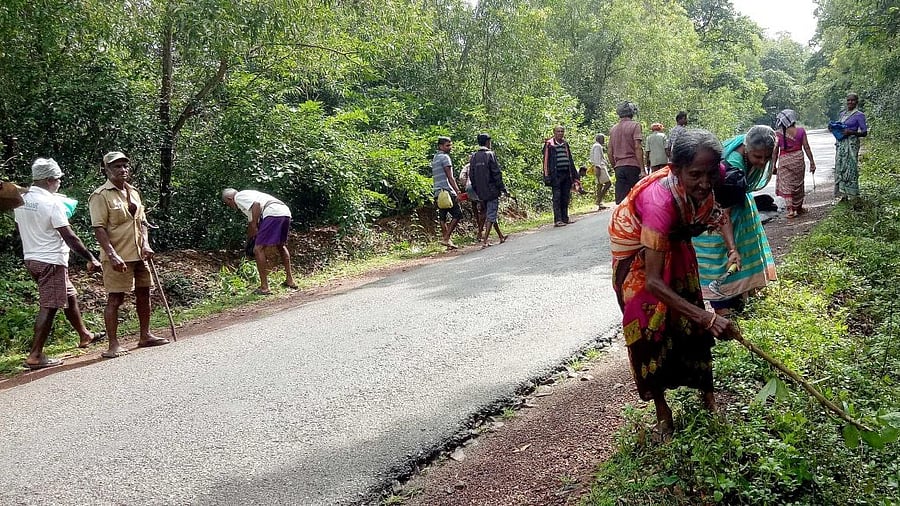
Halkar villagers cleaning the area near the forest; a welcome arch installed by the village forest panchayat.
Photos by M G Naik
As forest encroachment and degradation become common, especially around urban areas, Halkar village in Uttara Kannada district and its achievements in conservation stand out. Thanks to the century-old Halkar village forest panchayat (VFP), with forest-loving residents as its members, the village has been able to safeguard 219 acres of surrounding forests.
The Panchayat was established in 1924 and is a relic of the colonial British government. It was one among those bodies entrusted with the management of forest patches that had become ‘uneconomic for the government’ and was set up based on the recommendations of forest settlement officer G F S Collins.
These efforts towards forest conservation are especially important, given the location of the village. Sitting on the banks of the Aghanashini estuary, now a Ramsar site (a wetland that has been designated as internationally important for its conservation and sustainable use).
Scientist M D Subash Chandran, who resides in Kumta and has been observing Halkar village forest for decades, says that though the formal administrational structure of the village forest panchayat was established in 1924, the forest was already under community management for generations.
“The Halkar forest also has traditional folk deities and villagers experience a great sense of belongingness and protection. The tree cover has grown thicker in the last three decades. Forest resources will be protected if more community-managed models exist,” says Subash Chandran. He observes that more native varieties, like kokum, should be grown to enrich livelihoods and biodiversity.
Environment writer Shivanand Kalave, who has studied the village forest panchayat records, explains that the body has always been strict with adhering to rules and implementing protective measures. For instance, in 1928, a few villagers were fined for not participating in sapling plantation.
Halkar village in Uttara Kannada district
“This is the only village forest panchayat still functioning in the state. The land is jointly owned by the revenue department and the village forest department. The panchayat is an example of how alert villagers can conserve forests and save land from encroachment,” says Nagaraj Bhat, the chairman of the village forest panchayat. Since its inception, successive generations of villagers in Halkar have taken on the mantle of preserving the ecosystem.
The continued existence of the administrative body has not been without threats. The then deputy commissioner issued an order regarding the dissolution of the body in 1979 under the Karnataka Forest Act. The panchayat was part of a legal fight in the high court and received a favourable judgement, 10 years later. Out of 233 acres of forests, the body has lost only 14 acres to the Konkan Railway tracks.
Community patrols
Shantaram Harikantra, the secretary of the village forest panchayat, says many officials are not aware of their responsibility to hold the VFP’s managing committee elections once in three years, as this is the only such body functioning under an old law. Elections were held recently, after a gap of a decade, he says. “We do not have politics in the VFP which has true democracy in decision-making and we have no compromise regarding the forest,” he adds.
Halkar village in Uttara Kannada district
According to Bhat, there is an increased threat of pollution today as tourists and others are attempting to dispose of garbage in the forest area. “We are urging the government to arrange for proper fencing,” he says.
“In case of any violation, when somebody is found dumping garbage, our watchman and villagers catch them,” says Harikantra. Combined patrols and vigilance have ensured that there are no attempts at encroachment.
The administrative body also retains many old rules, villagers cannot carry sickles or axes while entering this forest. The panchayat also regulates how much biomass a family is able to use and issues ‘passes’. Families that have such passes are allowed to take only one head-load of dry leaves or twigs a day.
Such unique century-old rules, including fines, aimed at balancing conservation and utilisation of the forest by the local community itself are what makes the body successful in community management even today.
“New houses have been constructed in other villages instead, and local villagers plant native varieties of trees, and strengthen trenches every year,” Harikantra adds.
Villagers are given an even share of the fine amount collected. Additionally, cashew nuts, suragi and fallen trees are auctioned to villagers at a concessional price.